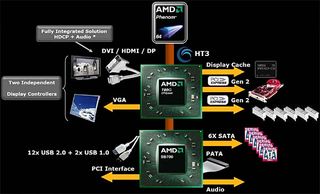AMD and Nvidia Platforms Do Battle

Hybrid Graphics Platforms to Fire Up Multi-GPU Rendering?
Integrated chipsets have always been both a blessing and a curse. On the one hand, increased integration of features such as audio, networking, graphics and connectivity options helps to drastically cut system cost and reduce power consumption. On the other hand, those features tend to lack punch, especially on the graphics side. As a result, we’ve always recommended against gaming on a platform that runs integrated graphics.
While this is still the case with the latest product generation by AMD/ATI and Nvidia, there is substantially more value now. AMD’s 780G and the GeForce 8200/8300 are the first generation of platforms that add component interaction on top of integration, providing a new meaning to “multi-GPU”.
All chipset makers have been trying to upgrade features and increase performance, although the graphics makers AMD/ATI and Nvidia have less interest in furnishing motherboard core logic with true high performance graphics features. This is because they risk cannibalizing part of their discrete graphics business, and because complex graphics increases cost. Since Intel owns the majority of the integrated chipset market, a perfect balance among features, performance and cost is imperative to conquer market share in this high volume segment.
Features, Features
AMD and Nvidia are thus focused on providing as much bang for the buck as possible, which means integrating all the features users want in a desktop PC or HTPC solution, while looking at power efficiency in the sub $100 space for motherboards. At the same time, both firms realized that features have to allow better flexibility and platform control, letting users get the best of both worlds: a decent platform, and modern integrated graphics paired with efficient upgrade paths.
Platform Strategies Everywhere
Clearly, AMD/ATI and Nvidia not only invest into the chipset market because they want to become core logic providers per se, but also because a solid platform strategy helps to bind the customer to a particular platform when it comes to upgrades. The formula is simple: provide all the features that users would expect these days — namely PCI Express graphics with HD video capabilities — and a plethora of interfaces, including Serial ATA with Command Queuing and many USB 2.0 ports. Then close the deal with a differentiator that turns the mainstream platform into a potentially powerful, yet reasonable system, which I referred to as component interaction.
Stay On the Cutting Edge: Get the Tom's Hardware Newsletter
Get Tom's Hardware's best news and in-depth reviews, straight to your inbox.
Since AMD/ATI and Nvidia have a strong focus on graphics, both the AMD 780G and Nvidia’s GeForce 8200/8300 come with hybrid graphics features, allowing users to take advantage of multi-GPU features in a way that actually makes sense for the majority of users. This means using the power-efficient integrated graphics for Windows and video playback, and upgrading to one or multiple graphics cards that are only active for 3D-intensive software.
We can dare to predict that an increasing number of platforms will be equipped with integrated graphics in the not too distant future, for the sake of convenience. Let’s first look at what ASRock created, though, out of the two all-in-one hybrid chipsets by AMD and Nvidia.
Current page: Hybrid Graphics Platforms to Fire Up Multi-GPU Rendering?
Next Page The Rebirth of Multi-GPU Graphics